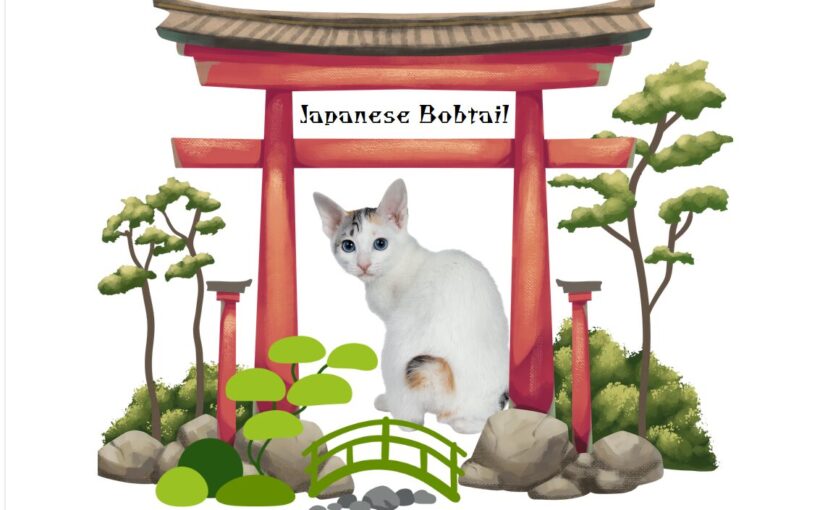When it comes to distinctive cat breeds, few are as iconic or steeped in cultural significance as the Japanese Bobtail. Renowned for their unique appearance and rich history, these cats are celebrated as symbols of good luck and prosperity in Japan. Whether you’re a lifelong cat lover or simply curious about this captivating breed, here’s everything you need to know about the Japanese Bobtail.
A Brief History of the Japanese Bobtail
The Japanese Bobtail has an ancient lineage, with records of their existence dating back over 1,000 years. These cats are prominently featured in Japanese folklore and art, often depicted with their trademark short, fluffy tails. Their presence in Japan’s history is so enduring that they are believed to have been companions of royalty and nobility.
The most famous representation of the Japanese Bobtail is the maneki-neko, or “beckoning cat,” a figurine thought to bring good fortune. This iconic symbol, often found in homes and businesses, typically features a bobtailed cat raising one paw as if to welcome prosperity.
The breed was introduced to the United States in the 1960s, quickly gaining popularity among cat enthusiasts for its charming personality and exotic appearance. Today, the Japanese Bobtail is recognized by major cat associations such as The International Cat Association (TICA) and the Cat Fanciers’ Association (CFA).
Physical Characteristics
The Japanese Bobtail is instantly recognizable thanks to its short, pom-pom-like tail, which is as unique to each cat as a fingerprint. The tail is caused by a natural genetic mutation and is often curved or kinked, giving it a fluffy, pom-pom effect.
Other defining features include:
- Body Type: These cats have a slender, athletic build with long legs, making them agile and graceful.
- Head Shape: A triangular head with high cheekbones and large, expressive eyes contributes to their lively appearance.
- Coat: Japanese Bobtails come in both short-haired and long-haired varieties. Their coats are silky and low-maintenance.
- Colors: They are known for their vibrant and varied coat colors, but the tricolored mi-ke (pronounced “mee-keh”), a combination of white, black, and orange, is the most iconic.
Personality and Temperament
Japanese Bobtails are often described as “dog-like” due to their playful, outgoing nature. They are highly social and form strong bonds with their families. Here are some traits that make them stand out:
- Affectionate: These cats thrive on human interaction and enjoy being part of the action.
- Intelligent: Japanese Bobtails are quick learners who often enjoy interactive toys and puzzles.
- Vocal: Known for their melodic chirps and trills, they are not shy about communicating their needs.
- Active: Their athleticism means they love to jump and explore, so a home with plenty of climbing opportunities is ideal.
Health and Lifespan
Japanese Bobtails are generally a healthy breed with few genetic health issues. With proper care, they can live well into their teens, with some cats reaching 15 years or more.
To keep your Japanese Bobtail in top shape:
- Schedule regular vet check-ups.
- Provide a balanced, high-quality diet.
- Ensure they get plenty of exercise to maintain a healthy weight.
Grooming Needs
One of the perks of owning a Japanese Bobtail is their low-maintenance grooming routine. Both short-haired and long-haired varieties have coats that resist matting and shedding. Weekly brushing is usually sufficient to keep their coats sleek and shiny.
Is a Japanese Bobtail Right for You?
Japanese Bobtails are a wonderful choice for families, singles, and anyone looking for an active, affectionate companion. They do well in households with children and other pets, thanks to their friendly and adaptable nature.
However, their energy levels mean they need plenty of stimulation, so they may not be the best fit for someone looking for a more independent or low-energy pet.
How to Find a Japanese Bobtail
If you’re ready to welcome a Japanese Bobtail into your home, consider the following options:
- Breeders: Reputable breeders are your best bet for finding a healthy, well-socialized kitten. Ensure the breeder is registered with a recognized cat association.
- Rescue Organizations: Some rescue groups specialize in specific breeds, including Japanese Bobtails.
- Cat Shows: Attending cat shows can connect you with breeders and experts who can guide you in your search.
Fun Facts About Japanese Bobtails
- They’re Natural Artists: Japanese Bobtails are often featured in ancient woodblock prints, reflecting their cultural significance.
- A Unique Walk: Thanks to their long hind legs, these cats have a distinctive, bunny-like gait.
- Good Luck Charms: Many believe owning a Japanese Bobtail brings good fortune and happiness.
Conclusion
The Japanese Bobtail is much more than a pretty face. With their rich history, unique appearance, and delightful personality, they’re a breed that captures hearts wherever they go. Whether you’re drawn to their role in Japanese culture or their playful, affectionate nature, the Japanese Bobtail makes a fantastic addition to the right home.
If you’ve fallen in love with this breed, take the next step to learn more about how to welcome one into your family. And don’t forget to share your own Japanese Bobtail stories in the comments below!







Your stuffs great at all times, keep it up!